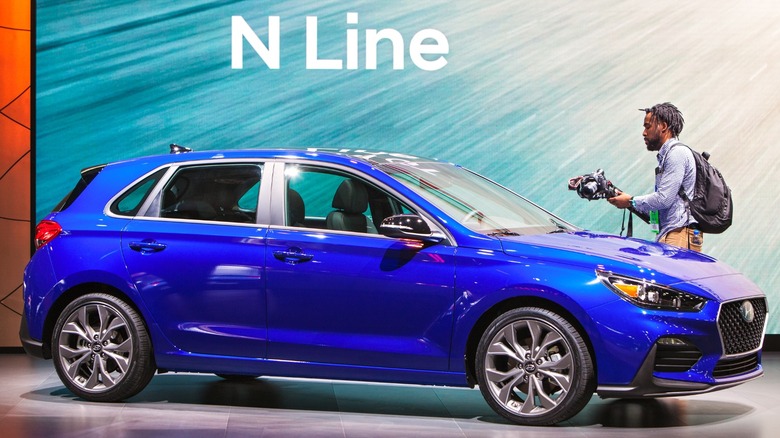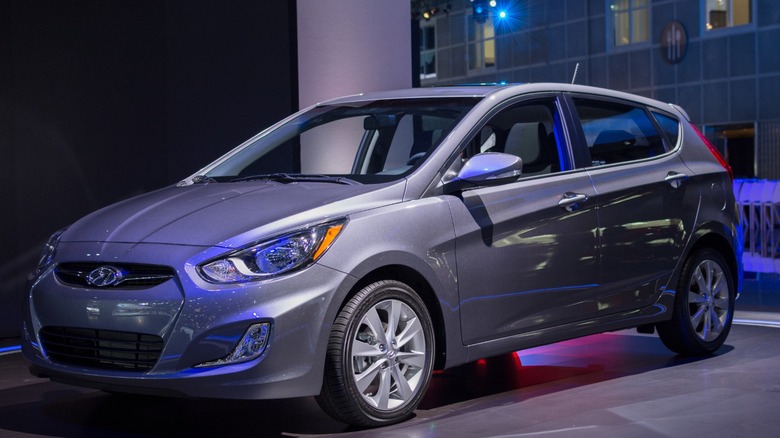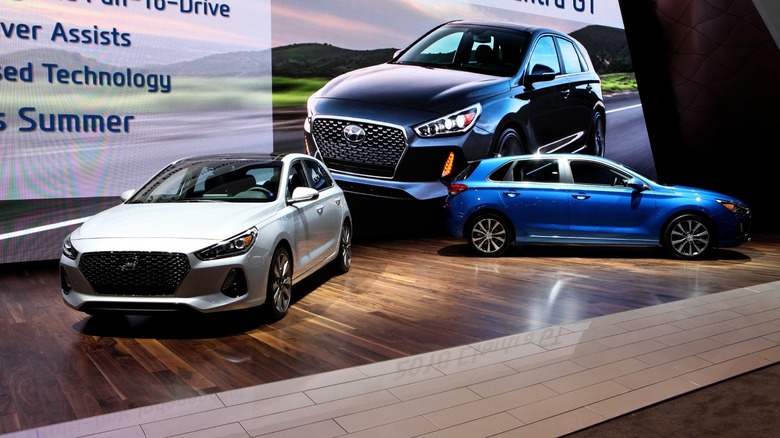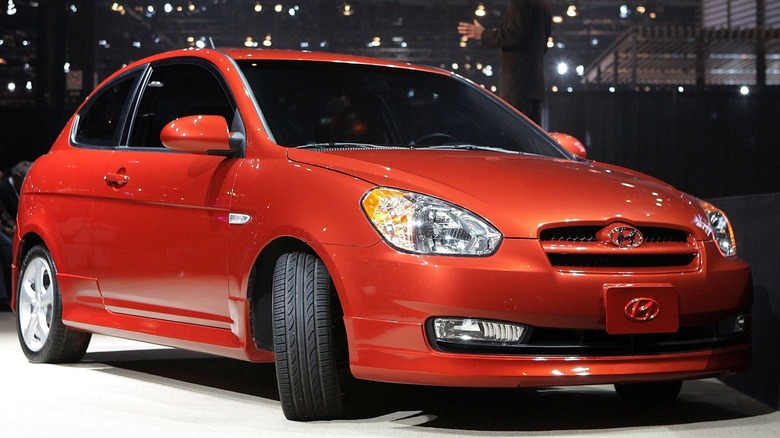The Key Differences Between Hyundai Elantra GT & Accent Hatchbacks
If you're looking for a used affordable and reliable hatchback, you should consider getting a Hyundai. But if you do your research, you'll find two options: the Elantra GT and the Accent Hatchback. These cars are excellent models, and you can find both in our list of most reliable Hyundais.
Since both cars are hatchbacks, they're practical and allow you the flexibility of a large cargo space. However, the Accent is a smidge smaller than the Elantra, especially as the former fits in the B-Segment, while the latter competes in the larger C-Segment. Nevertheless, they're close enough in price that you might be tempted to get either car.
So, how do you pick the Hyundai hatchback that is right for you? Aside from the naming conventions, let's check out the key differences between these two models to help you pick the right car before you head to the dealership to buy one for yourself, your family, or even your friends.
The Hyundai Elantra GT
The Hyundai Elantra GT is the hatchback version of the Elantra and is the bigger car between the two. It's called the i30 in Europe and we named it as our favorite hatchback from Hyundai in our list of the coolest hatchback from every major car brand. Unfortunately, the company discontinued it after the 2020 model year, so you can no longer get a new Elantra GT from the dealer.
Nevertheless, the Elantra GT is a great hatchback and was the first Hyundai to get the N treatment. The five-door version of the Elantra that was first offered in the States was the 2013 model year, and you can get it with a 1.8-liter engine and a six-speed manual or automatic transmission. It received a bigger 2.0-liter engine the following year, and it stayed the same until Hyundai gave it a facelift in 2016.
The second-generation Elantra GT arrived with the 2018 model, and Hyundai introduced a Sport version with a turbocharged 1.6-liter engine, paired to either a six-speed manual or a seven-speed dual-clutch transmission (DCT). However, you can still get it with a naturally-aspirated 2.0-liter engine with a six-speed automatic if you want a more sedate drive.
The Hyundai Accent Hatchback
The Accent Hatchback is Hyundai's smaller hatchback offering, but it's been around the market since 1995. Unfortunately, the company discontinued the body style in 2017, and fully stopped making the Accent model in 2022. Nevertheless, there are still many good examples of the Accent Hatchback if you're on the market for a used vehicle.
The first three-door Accent hatchback had a 1.5-liter engine, and it came with either a five-speed manual or a four-speed automatic. Hyundai then gave it a larger 1.6-liter engine starting with the 2001 model year.
The last hatchback generation, from model years 2012 to 2017, retained the 1.6 engine. However, Hyundai upgraded the car's transmission options, allowing customers to pick between a six-speed manual or automatic.
Given that the Elantra GT had a higher price point than the Accent hatchback when it was new, you can expect the Elantra GT to have a more luxurious interior. Since both cars have multiple generations and have been discontinued for a few years, let's focus on the most-recent model of each (the 2017 Accent Hatchback versus the 2020 Elantra GT) and what you get with each model.
Size Differences and fuel efficiency
The Elantra GT is 170.9 inches long, while the Accent Hatchback is only 162 inches, giving the Elantra close to a 9-inch advantage. This results is more legroom, especially for passengers in the back, and a bigger cargo compartment. Furthermore, the Elantra GT is 3.8 inches wider (70.7 inches versus 66.9 inches) and 0.6 inches taller (57.7 inches versus 57.1 inches).
While the size advantage makes the Elantra GT a bit more comfortable, it also makes it heavier. The Elantra GT weighs 2,943 pounds, while the Accent Hatchback only comes in at 2,546 pounds. The extra 400 pounds on the Elantra GT makes it less efficient, especially as it requires a larger engine to drive the vehicle.
The Elantra GT, with its 2.0-liter engine, can only get 24 mpg in the city and 32 mpg on the highway, leading to a combined EPA rating of 27 mpg. On the other hand, the Accent Hatchback gets 27 mpg in the city and 37 mpg on the highway, with a combined EPA rating of 31 mpg.
A 1.6-liter versus a 2.0-liter engine
Of course, not everything is about size and fuel consumption; after all, we sometimes rate our cars according to its smiles per mile. The Hyundai Accent is primarily an economy car, so the last model year of the hatchback only came with one engine option — a 1.6-liter four-cylinder engine. This small engine delivers 137 hp and 123 lb-ft of torque through the Accent line, although you could at least choose between an automatic or manual transmission.
On the other hand, the 2020 Elantra GT came in two flavors: the base GT and the sportier GT N Line, which was called the GT Sport prior to the introduction of its N performance brand. We will focus first on the base GT, which came with a 2.0-liter engine. This larger engine in the Elantra GT produced 162 hp and 150 lb-ft of torque, giving it about 25 more horses over the Accent Hatchback.
The six-speed manual Accent Hatchback has an 8.8-second 0-60 time and can cover the quarter mile in 16.9 seconds. It can also hit a top speed of 133 mph. The six-speed manual Elantra GT with a 2.0-liter engine gets an 8.2-second 0-60 time and finishes the quarter mile in 16.3 seconds. It also has a top speed of 136 mph. This shows that the Accent Hatchback and base Elantra GT have almost the same performance, so you won't miss out on much if you choose the slightly cheaper model.
The turbo option in the Elantra GT
But if you want more performance and like the looks of Hyundai's hatchbacks, consider going for the Elantra GT Sport or Elantra GT N Line. This variant replaces the naturally-aspirated 2.0-liter engine with a turbocharged 1.6-liter. It also gives you the option of a six-speed automatic or a seven-speed DCT, giving it better fuel efficiency.
The turbocharged engine bumps the power output to 201 hp and 195 lb-ft of torque, giving it a 39-horsepower advantage over the base GT and 64 more horsepower than the Accent Hatchback. If you want to take the six-speed manual Elantra GT N Line to the track, you can hit 0-60 in 7 seconds flat and finish the quarter mile in 15.2 seconds. You also get a top speed of 146 mph, 10 more than what the base Elantra GT could manage.
These numbers are not mind blowing, after all the Elantra GT is less of a performance car and more of a daily driver. However, you could at least get some smiles out of it on the open road without having to break the bank.
Model year availability
Since the Accent Hatchback is the less expensive and older model, you're more likely to find it at a more affordable price. This is especially true as the latest version of the Accent Hatchback you can buy today is at least seven years old. And if you're really looking for a cheap hatchback, the 2011 model year uses one of the most reliable engines Hyundai ever built.
But if you want something a bit newer, you should look at the Elantra GT instead. Since it was only discontinued in 2021, you can still find relatively fresh examples of this hatchback. It will also tend to be more comfortable and have more advanced features, owing to its higher ranking in Hyundai's lineup. However, if you're on a budget, you'll find more affordable options for the Accent Hatchback, especially as the Elantra GT only launched in 2013.
Both the Accent Hatchback and the Elantra GT are great hatchbacks and would be excellent options as a first car, even if you can only get them used. As long as you know what to look out for when buying a pre-owned car, you could get many more years and miles out of these cars.






